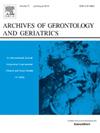Sarcopenia and intrinsic capacity in older adults: A systematic review
IF 3.8
3区 医学
Q2 GERIATRICS & GERONTOLOGY
引用次数: 0
Abstract
Introduction
Sarcopenia and intrinsic capacity are closely linked factors that impact the health and functional aging of older adults.
Objective
This systematic review aims to investigate the associations between the domains of IC and sarcopenia in older adults.
Material and methods
The study follows PRISMA guidelines and is registered on PROSPERO. The review included original studies (cohort, cross-sectional, or randomized controlled trials) with participants aged 60+ diagnosed with sarcopenia (based on EWGSOP or other recognized definitions). Intrinsic capacity (IC) was assessed based on the five domains defined within the IC framework—cognition, locomotion, sensory, psychological, and vitality. The Integrated Care for Older People (ICOPE) approach developed by the World Health Organization supports the optimization of IC and functional ability through person-centred and coordinated care. Exclusion criteria included studies with insufficient data on sarcopenia prevalence and IC scores, as well as reviews or studies unrelated to sarcopenia or IC.
Results
A total of 397 articles were identified, with 5 meeting the inclusion criteria. These studies, involving 6651 participants aged 60 to 82 years (54.8 % male, 45.2 % female), examined the association between sarcopenia and intrinsic capacity in older adults, using the diagnostic criteria for sarcopenia proposed by the EWGSOP and assessing IC based on its key components. Despite the limited number of studies, the findings suggest a significant link between declining intrinsic capacity and sarcopenia.
Final considerations
These results underscore the importance of a multifactorial approach in assessing and managing sarcopenia, which may improve early detection and support healthy aging.
老年人骨骼肌减少症和内在能力:一项系统综述
骨骼肌减少症和内在能力是影响老年人健康和功能衰老的密切相关因素。目的本系统综述旨在探讨老年人IC域与肌肉减少症之间的关系。材料和方法本研究遵循PRISMA指南,并在PROSPERO上注册。本综述纳入了原始研究(队列、横断面或随机对照试验),参与者年龄在60岁以上,诊断为肌肉减少症(基于EWGSOP或其他公认的定义)。内在能力(IC)是根据IC框架内定义的五个领域——认知、运动、感觉、心理和活力来评估的。世界卫生组织制定的老年人综合护理办法(ICOPE)通过以人为本的协调护理,支持优化老年人综合护理和功能能力。排除标准包括关于肌少症患病率和IC评分数据不足的研究,以及与肌少症或IC无关的综述或研究。结果共纳入397篇文章,其中5篇符合纳入标准。这些研究涉及6651名年龄在60至82岁之间的参与者(54.8%为男性,45.2%为女性),使用EWGSOP提出的肌肉减少症诊断标准并根据其关键成分评估IC,研究了老年人肌肉减少症与内在能力之间的关系。尽管研究数量有限,但研究结果表明内在能力下降与肌肉减少症之间存在显著联系。这些结果强调了多因素方法在评估和治疗肌肉减少症中的重要性,这可能会提高早期发现和支持健康老龄化。
本文章由计算机程序翻译,如有差异,请以英文原文为准。
求助全文
约1分钟内获得全文
求助全文
来源期刊
CiteScore
7.30
自引率
5.00%
发文量
198
审稿时长
16 days
期刊介绍:
Archives of Gerontology and Geriatrics provides a medium for the publication of papers from the fields of experimental gerontology and clinical and social geriatrics. The principal aim of the journal is to facilitate the exchange of information between specialists in these three fields of gerontological research. Experimental papers dealing with the basic mechanisms of aging at molecular, cellular, tissue or organ levels will be published.
Clinical papers will be accepted if they provide sufficiently new information or are of fundamental importance for the knowledge of human aging. Purely descriptive clinical papers will be accepted only if the results permit further interpretation. Papers dealing with anti-aging pharmacological preparations in humans are welcome. Papers on the social aspects of geriatrics will be accepted if they are of general interest regarding the epidemiology of aging and the efficiency and working methods of the social organizations for the health care of the elderly.

 求助内容:
求助内容: 应助结果提醒方式:
应助结果提醒方式:


